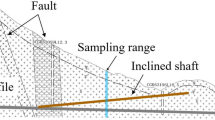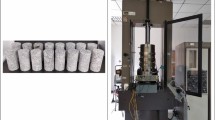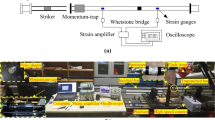Abstract
The micromechanical damage mechanics formulated by Ashby and Sammis (Pure Appl Geophys 133(3) 489–521, 1990) has been shown to give an adequate description of the triaxial failure surface for a wide variety of rocks at low confining pressure. However, it does not produce the large negative curvature in the failure surface observed in Westerly granite at high confining pressure. We show that this discrepancy between theory and data is not caused by the two most basic simplifying assumptions in the damage model: (1) that all the initial flaws are the same size or (2) that they all have the same orientation relative to the largest compressive stress. We also show that the stress–strain curve calculated from the strain energy density significantly underestimates the nonlinear strain near failure in Westerly granite. Both the observed curvature in the failure surface and the nonlinear strain at failure observed in Westerly granite can be quantitatively fit using a simple bi-mineral model in which the feldspar grains have a lower flow stress than do the quartz grains. The conclusion is that nonlinearity in the failure surface and stress–strain curves observed in triaxial experiments on Westerly granite at low loading rates is probably due to low-temperature dislocation flow and not simplifying assumptions in the damage mechanics. The important implication is that discrepancies between experiment and theory should decrease with increased loading rates, and therefore, the micromechanical damage mechanics, as formulated, can be expected to give an adequate description of high strain-rate phenomena like earthquake rupture, underground explosions, and meteorite impact.












Similar content being viewed by others
References
Ashby, M., and S. D. Hallam Née Cooksley (1986), The failure of brittle solids containing small cracks under compressive stress states, Acta Metall. Mater., 34(3), 497–510.
Ashby, M. F., and C. G. Sammis (1990), The damage mechanics of brittle solids in compression, Pure Appl. Geophys., 133(3), 489–521.
Ashby, M. F., and R. A. Verrall (1977), Micromechanisms of flow and fracture, and their relevance to the rheology of the upper mantle, Phil. Trans. R. Soc. Lond. A, 288, 59–95.
Bass, J. (1995), Elasticity of minerals, glasses, and melts, in Mineral Physics and Crystallography: A Handbook of Physical Constants, vol. 2, edited by T. J. Ahrens, pp. 45–63, American Geophysical Union.
Baud, P., A. Schubnel, and T. Wong (2000a), Dilatancy, compaction, and failure mode in Solnhofen limestone, J. Geophys. Res., 105(B8), 19,289–19,303.
Baud, P., W. Zhu, and T. Wong (2000b), Failure mode and weakening effect of water on sandstone, J. Geophys. Res., 105(B7), 16,371–16,389.
Brace, W. F. (1965), Some new measurements of linear compressibility of rocks, J. Geophys. Res., 70(2), 391–398.
Byerlee, J. (1967), Frictional characteristics of granite under high confining pressure, J. Geophys. Res., 72(14), 3639–3648.
Deshpande, V. S., and A. G. Evans (2008), Inelastic deformation and energy dissipation in ceramics: A mechanism-based constitutive model, J. Mech. Phys. Solids, 56(10), 3077–3100.
Hadley, K. (1976), Comparison of calculated and observed crack densities and seismic velocities in westerly granite, J. Geophys. Res., 81(20), 3484–3494.
Hamiel, Y., Y. Liu, V. Lyakhovsky, Y. Ben-Zion, and D. Lockner (2004), A viscoelastic damage model with applications to stable and unstable fracturing, Geophys. J. Int., 159(3), 1155–1165.
Huffman, A., J. Brown, N. Carter, and W. Reimold (1993), The microstructural response of quartz and feldspar under shock loading at variable temperatures, J. Geophys. Res., 98(B12), 22,171–22,197.
Jeyakumaran, M., and J. W. Rudnicki (1995), The sliding wing crack—again, Geophys. Res. Lett., 22(21), 2901–2904.
Johnson, L. R., and C. G. Sammis (2001), Effects of rock damage on seismic waves generated by explosions, Pure Appl. Geophys., 158(11), 1869–1908.
Kachanov, M. L. (1982a), A microcrack model of rock inelasticity part I: Frictional sliding on microcracks, Mech. Mater., 1(1), 19–27.
Kachanov, M. L. (1982b), A microcrack model of rock inelasticity part II: Propagation of microcracks, Mech. Mater., 1(1), 19–27.
Kostrov, B. V. (1974), Seismic moment and energy of earthquakes, and seismic flow of rock, Izv. Acad. Sci. USSR Phys. Solid Earth, 1, 23–44.
Liu, C., and A. J. Rosakis (1994), Investigation of transient effects for dynamically initiating and growing cracks under stress wave loading conditions, in Dynamic Fracture Mechanics, edited by M. H. Aliabadi, chap. 4, Computational Mechanics Publication, Southhampton, UK; Boston, USA.
Liu, C., W. G. Knauss, and A. J. Rosakis (1998), Loading rates and the dynamic initiation toughness in brittle solids, Int. J. Fract., 90(1), 103–118.
Lockner, D. (1998), A generalized law for brittle deformation of westerly granite, J. Geophys. Res., 103(B3), 5107–5123.
Lyakhovsky, V., Y. Ben-Zion, and A. Agnon (1997), Distributed damage, faulting, and friction, J. Geophys. Res., 102(27), 635–27.
Lyakhovsky, V., Y. Ben-Zion, and A. Agnon (2005), A viscoelastic damage rheology and rate- and state-dependent friction, Geophys. J. Int., 161(1), 179–190.
Nemat-Nasser, S., and H. Horii (1982), Compression-induced nonplanar crack extension with application to splitting, exfoliation, and rockburst, J. Geophys. Res., 87(B8), 6805–6821.
O’Connell, R. J., and B. Budiansky (1974), Seismic velocities in dry and saturated cracked solids, J. Geophys. Res., 79(35), 5412–5426.
Owen, D. M., S. Zhuang, A. J. Rosakis, and G. Ravichandran (1998), Experimental determination of dynamic crack initiation and propagation fracture toughness in thin aluminum sheets, Int. J. Fract., 90(1), 153–174.
Rosakis, A., and A. Zehnder (1985), On the dynamic fracture of structural metals, Int. J. Fract., 27(3), 169–186.
Schock, R., and H. Heard (1974), Static mechanical properties and shock loading response of granite, J. Geophys. Res., 79, 1662–1666.
Shimada, M. (1981), The method of compression test under high pressures in a cubic press and the strength of granite, Tectonophysics, 72(3-4), 343–357.
Tada, H., P. C. Paris, and G. R. Irwin (1985), The stress analysis of cracks handbook, Paris Productions (and Del Research Corp.) St. Louis, MO.
Wawersik, W. (1973), Time-dependent behavior of rock in uniaxial compression, in Proc. 14th Symposium on Rock Mechanics, pp. 85–106.
Zehnder, A. T., and A. J. Rosakis (1990), Dynamic fracture initiation and propagation in 4340 steel under impact loading, Int. J. Fract., 43(4), 271–285.
Acknowledgments
The authors would like to thank Yehuda Ben-Zion and three anonymous reviewers for their constructive reviews. This research was funded through the National Science Foundation collaborative grant EAR-0711171 to the University of Southern California and the California Institute of Technology, the National Science Foundation for the research grant (award no. EAR-0911723), provided under the American Recovery and Reinvestment Act of 2009 (ARRA) (Public Law 111-5) and the Department of the Air Force though Grant #FA8718-08-C-0026.
Author information
Authors and Affiliations
Corresponding author
Appendices
Appendix A: Calculating the Strain Energy and Axial Strain Due to Sliding on the Initial Inclined Cracks
The average value of the stress intensity factor, K around the edge of the crack in Eq. 6 is
and Eq. 6 becomes
The uniaxial strain \(\epsilon_{1}\) can be calculated as (recall that \(\sigma_{s} = \tau + \mu \sigma_{n}\))
In terms of the principal stresses
Appendix B: Estimation of Nonlinear Strain From the Moment Tensors
A second estimate of the strain associated with the damage can be obtained by summing the seismic moments of the individual flaws. Kostrov (1974) gives the following expression for the macroscopic strain in a volume V containing n flaws
Johnson and Sammis (2001) express the scalar moment density associated with an individual angle crack and its wing cracks as a shear moment associated with sliding on the angle crack and a tensile moment associated with the opening of the wing cracks.
where
In these expressions Johnson and Sammis (2001) ignore the β factor in Ashby and Sammis (1990) since it gives a contribution to the moment at zero stress. Note that the tensile opening of the wing cracks makes an increasingly dominant contribution as the damage increases.
For a crack opening in the x 2 direction, the moment density tensor is
where \(\zeta = \frac{\lambda}{\lambda + \mu} = 1-\frac{c_{s}^{2}}{c_{p}^{2}}\). Here c s and c p are the S- and the P-wave speeds, respectively.
Kostrov’s expression for the axial strain is
For \(\Uppsi = 45\deg\) we have
The first term in the curly brackets is associated with sliding on the initial angle cracks while the second term is associated with tensile opening of the wing cracks.
Rights and permissions
About this article
Cite this article
Bhat, H.S., Sammis, C.G. & Rosakis, A.J. The Micromechanics of Westerley Granite at Large Compressive Loads. Pure Appl. Geophys. 168, 2181–2198 (2011). https://doi.org/10.1007/s00024-011-0271-9
Received:
Revised:
Accepted:
Published:
Issue Date:
DOI: https://doi.org/10.1007/s00024-011-0271-9




